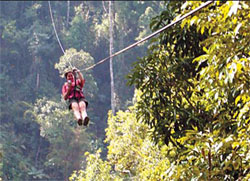Discovering some monkey magic
A visitor to the Gibbon Experience in northern Laos uses a zip-line, some of which are up to 30 meters above the ground and 300 meters long, to traverse over the Bokeo Nature Reserve. |
Through a network of zip-lines through the canopy of Bokeo Nature Reserve in northern Laos, the aptly named Gibbon Experience gives visitors an exhilarating insight into what it must feel like to be a small ape.
Though gibbons are able to swing distances of up to 15 meters from tree to tree and at speeds of up to 55 kilometers per hour, humans need the assistance of harnesses and wires mounted high on trees.
And as fun as it is to swing through the tropical jungle, scanning the branches for the once-thought extinct Black Gibbon, Nomascus concolor lu, the reason there are zip-lines in a remote corner of northern Laos is to conserve the vast Bokeo nature reserve.
The Gibbon Experience has built an ingenious system of tree houses connected by zip-lines to raise funds to protect the wildlife as well as assist local communities in providing alternatives to slash-and-burn farming.
Getting there is an experience in itself. Departure point is Houayxai, a border town with Thailand on the Mekong River, for a three-hour drive through the red dust of road construction and off-road roller coaster track to the Hmong village of Ban Toup.
After several river crossings and an hour's trek, mostly upwards, our group arrived at a hut where we donned our harnesses, and after a brief safety briefing, were ready for our first zip.
Local guides helped us to hook-up to the cable then it was leap of faith off a platform and a glide into a tree house mounted on a majestic strangler fig tree. The project has a total of five tree houses, but our group, on the classic tour, were staying in three of them, each accessed only via zip-line.
To limit impact, the project only takes 12 visitors at a time on the classic tour and eight for the further afield waterfall experience.
After some refreshments and some giant squirrel and bird watching, more guides arrived to lead half of the group to their sky-high beds. The zip out of tree house number one was a breathtaking rush that was over too quickly. Luckily, there were two more long glides and a few short hikes to go before we caught site of tree house two.
Though it was only late afternoon, we said goodnight to the English couple residing in the tree house built for two. It took a 20-minute walk through tropical jungle to the zip-line that would lead to tree house number three, known for its spectacular sunset vistas.
Each tree house is stocked with a generous amount of snacks and fruit, necessities such as tea, coffee and candles, and offers unique facilities a toilet with a view. Due to our remoteness, dinner was zipped in by one of the guides.
After the adrenaline rush of the zips the pace slowed down dramatically, there was nothing to do now but gaze out at valley after valley of lush green, void of any signs of human habitation. The binoculars were out, but more was heard than seen. At dusk barking deer started their calls, sounding like a cross between a donkey and a dog, and a cacophony of insects kept up a steady chorus.
After a healthy dinner by candlelight and some star gazing, it was time for sleep. The night proved far quieter than expected, but the morning was abuzz and we were rewarded for our journey deep into the woods with the high-pitched calls of Gibbons.
The Black Gibbons were only re-discovered in the area in 1997 and the project estimates there are up to 12 groups residing in the reserve.
The distinct humming of the zip-line told us a guide had arrived to lead us on a morning walk. We walked quietly, hoping to see a gibbon or some other wildlife, but instead we surprisingly came upon another zip-line, which at 300-meters was the longest one of all.
The rest of the day we were on our own, free to zip, hike or just enjoy nature. Luckily, some of us ended up sticking together and attempted to use MacGuyver-like skills to rescue one of our group that had slipped back on a line and found herself hanging on the downslope.
Once summoned, the guides came to the rescue, but just minutes later another member of our group found himself hanging by just his safety line, looking very ape-like, but this time we knew what to do and he was swiftly rescued.
Though the zip-lines make the experience fun, knowing that your fee for staying was going towards paying 10 forest guards to protect part of the 123,000-hectare wilderness against poachers and loggers gave the visit meaning and made an impact on visitor's awareness.
DPA
(China Daily 03/22/2007 page19)















